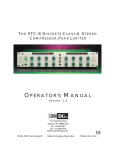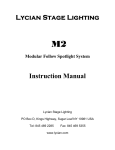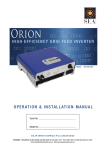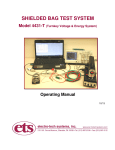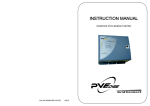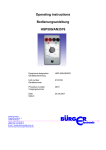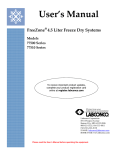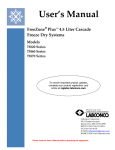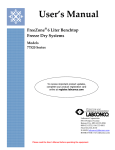Download DeLonghi Split Air Conditioner Installation manual
Transcript
OPERATING AND INSTALLATION MANUAL SINGLE SPLIT AIR-CONDITIONER AND HEAT PUMP a 0 41 R ce o Please carefully read this manual before operating the appliance. INDEX U I A Safety standards 2 U I A Identification of the parts 4 U I A Remote control 6 U I A Operating modes 8 U I A AUTO mode 9 U I A TIMER mode 9 U I A DRY mode 10 U I A SLEEP mode 10 U I A Maintenance 11 U I A Troubleshooting 12 I A Installation instructions 13 I A Installation of the indoor unit 15 I A Installation of the outdoor unit 19 I A Venting the air 19 U I A Note 20 U I A Useful information 20 U User SINGLE SPLIT I Installer A Service English 11/2002 1 SAFETY STANDARDS AND WARNINGS U I A Use the power supply voltage shown on the rating plate. Keep the power switch or plug clean. Connect the power cable correctly and securely to the outlet, avoiding the risk of electric shock or fire due to insufficient contact. Check that the outlet is suitable for the plug, otherwise have the outlet replaced. Do not use the power switch or pull out the plug to switch the appliance off when operating. This may cause fires due to sparks, etc. The user must contact qualified personnel to earth the appliance, in compliance with the legislation in force, and to install a thermal-magnetic circuit breaker. Do not bend, pull or press the power cable, as it may break. Electric shock or fire are usually caused by damaged power cables. The power cable must only be replaced by specialist technicians. Do not use power supply cables that are too long, or multiple adapters. Do not operate the air-conditioner with wet hands; this may cause electric shock. Do not block the air inlet or outlet of either the indoor or outdoor unit. Extended exposure to cold air is a health risk. If smoke or a smell of burning is detected, immediately disconnect power and contact the Service Centre. Do not modify or alter the characteristics of the appliance in any way. Contact the Service Centres authorised by the Manufacturer for all repairs. Incorrect repair may cause electric shock, etc. Make sure the appliance is disconnected from the power supply when not used for extended periods, and before performing any cleaning or maintenance operations. Do not install the appliance in environments where the air may contain gases, oil or sulphur, or near sources of heat. Check that the base of the outdoor unit is installed securely. This appliance must only be used by adults; do not allow children to play with the appliance. Do not climb onto or rest objects on the outdoor unit. Never insert sticks or tools into the appliance. This may cause injuries. 2 English 11/2002 SINGLE SPLIT Lowers the inside temperature by 5°C from the outside temperature Keep the appliance at least 50cm from flammable substances (alcohol, etc.) or from pressurised containers (e.g. spray cans). Selecting the most suitable temperature will avoid damaging the appliance. The direction of air flow must be adjusted correctly. The louvers must be adjusted downwards in heating mode, and upwards in cooling mode. Do not leave doors and windows open when the air-conditioner is operating for long periods. Do not aim the air stream directly at plants or animals. Do not spray water onto the air-conditioner. This appliance has been designed to air-condition the home and must not be used for other purposes, such as drying clothes, cooling food, etc. If the appliance is used in areas without the renewal of fresh air, precautions must be taken to prevent any leaks of refrigerant gas from stagnating in the environment and creating the risk of fire. Do not rest heavy or hot objects on the appliance. The packing materials are recyclable. It is therefore recommended to place them in suitable containers for separate waste disposal. At the end of its working life, take the air-conditioner to a special waste disposal centre. Only use the air-conditioner as shown in this booklet. These instructions are not intended to cover every possible situation that may arise. Common sense and prudence must be applied in the installation, operation and conservation of all household appliances. ※ Working temperature range Indoor side DB(℃) SINGLE SPLIT Outdoor side DB(℃) Maximum cooling 36 45 Minimum cooling 16 18 Maximum heating 30 27 Minimum heating 16 -10 English 11/2002 3 U IDENTIFICATION OF THE PARTS I A INDOOR UNIT 2 Air inlet 3 1 4 4 5 11 AUTO STOP TEST RUN 10 Air outlet AUTO TEST RUN STOP 6 7 8 9 4 AUTO STOP 4 12 OUTDOOR UNIT Air inlet 13 1 2 3 4 5 6 7 8 9 10 11 12 13 14 Front panel Air filter Electrostatic filter (optional) Manual switch Cable panel Activated carbon filter Louvers Signal receiver LED display Power plug Drain hose Remote control Handle Air outlet grill 14 Air outlet The above figure represents a simplified layout of the appliance and may not correspond to the appearance of the unit actually purchased. 4 English 11/2002 SINGLE SPLIT OPERATION AND DISPLAY 1 2 AUTO TEST RUN STOP 3 4 5 1. Manual switch This is used to start the appliance if the remote control is not working.* 2. Heating indicator This comes on when the appliance is in heating mode. 4. Operation indicator This comes on when the appliance is operating. 5. Signal receiver Receives the signals from the remote control. 3. Cooling indicator This comes on when the appliance is in cooling mode. The shape and the position of the switches and indicators may change according to the model, however their functions remain the same. Power on when grill open. *This operation must be carried out by specialist technicians. SINGLE SPLIT English 11/2002 5 U REMOTE CONTROL I A The remote control sends signals to the appliance. 1. Liquid crystal display Displays all the operating modes. 2. MODE button Used to select the operating mode. 3. FAN button Used to set the fan speed, in sequence, to automatic, low, medium, high. 4. SLEEP button Used to set or cancel SLEEP mode. 5. SWING button Used to start or stop the movement of the vertical louvers. 6. TIMER ON button When the appliance is off, this button is used to switch the air-conditioner on automatically. 1 3 2 4 5 6 8 7 9 10 Meaning of the symbols shown on the liquid crystal display: 7-8. ROOM TEMPERATURE SETTING buttons Used to set the room temperature. 9. TIMER OFF button When the appliance is on, this button is used to switch the air-conditioner off automatically. 10. button Used to switch appliance on or off. Automatic fan speed Low fan speed Medium fan speed High fan speed Cooling indicator Dehumidification indicator Fan only operation indicator Heating indicator Automatic mode indicator SLEEP indicator Louver swing indicator The display on the remote control remains on even when the unit is off. 6 English 11/2002 SINGLE SPLIT HOW TO FIT THE BATTERIES • Remove the cover of the battery compartment in the direction of the arrow. • Fit the new batteries, making sure the (+) and (-) signs on the battery match correctly. • Put the cover back on by sliding it into position. Use 2 x R03 AAA (1.5 V) batteries. Do not use rechargeable batteries. Replace the used batteries with new batteries of the same type when the display is no longer visible. The batteries last around one year. The batteries in the remote control must be disposed of appropriately according to the legislation in force in the country concerned. TIPS ON STORING AND USING THE REMOTE CONTROL The remote control can be stored in a special support mounted on the wall. Remote control holder The remote control holder is standard HOW TO USE THE REMOTE CONTROL To switch the air-conditioner on, aim the remote control towards the signal receiver. The remote control will work at a distance of up to 8 metres from the indoor unit. Store the remote control at least 1m from television sets or other electrical appliances. Signal receiver SINGLE SPLIT English 11/2002 7 U OPERATING MODES I A OPERATING MODES 1. Selecting the operating mode Each time that the MODE button is pressed the operating mode is changed, in the following sequence: FULL AUTO COOLING DRY FAN ONLY HEATING 2. FAN mode Each time that the FAN button is pressed, the speed is changed, in the following sequence: AUTO LOW MEDIUM HIGH 3. Setting the temperature Press once to increase the set temperature by 1°C. Press once to decrease the set temperature by 1°C. Range of temperature settings available: HEATING 16°C ~ 30°C COOLING 16°C ~ 30°C DEHUMIDIFICATION 16°C ~ 30°C FAN ONLY no setting allowed 4. Starting the appliance Press the button . 1 3 2 5 3 4 When the unit is switched on it will start operating in the mode selected prior to being switched off. 5. Adjusting the air flow Pressing the “SWING” button starts moving the air flow louvers start automatically; pressing the “SWING” button again stops the louvers. Do not move the vertical air flow louvers manually, as this may cause poor operation. If this happens, first turn the appliance off, then disconnect and reconnect it to the power supply. Adjusting the horizontal air flow (manual) Turn the louver sliders for the horizontal adjustment of the air outlet to change the angle of the air flow, as shown (the unit illustrated may be different from the air-conditioner you have purchased). 8 English 11/2002 Sliders for adjusting the horizontal air flow louvers. This operation must be carried out by specialist technicians. SINGLE SPLIT U I A AUTO MODE AUTO OPERATING MODES Press the MODE button until displaying AUTO ( ); in this mode, the temperature and the fan speed are set automatically based on the actual room temperature. The operating mode and the temperature setting depend on the room temperature. In AUTO mode, the pre-set temperature is 25°C in cooling mode, while the fan speed may change. Room temperature Mode 23°C ~ 26°C higher than 26°C Lower than 23°C FAN ONLY COOLING HEATING U I A TIMER MODE AUTOMATIC START After having switched the appliance off, press the T-ON button to set the time you want the air-conditioner to switch back on; pressing the T-ON button again increases the time by 30 minutes, until a maximum of 24 hours from when the TIMER is set. E.g.: If the setting is performed at 4 p.m. and the TIMER is set to 2.5h, the appliance will start at 6.30 p.m. 2.5 When the unit is switched on it will start operating in the mode selected prior to being switched off. AUTOMATIC STOP When the appliance is on, press the T-OFF button to set the time you want the air-conditioner to switch off; pressing the T-ON button again increases the time by 30 minutes, until a maximum of 24 hours from when the TIMER is set. E.g.: If the setting is performed at 8.30 p.m. and the TIMER is set to 3.5h, the appliance will switch off at midnight. SINGLE SPLIT English 11/2002 9 DRY MODE U I A U I A DEHUMIDIFICATION MODE Press the MODE button until displaying the DRY ( ) mode. The appliance will start according to the room temperature and the set temperature: • If the room temperature is lower than the set temperature, the compressor, the outdoor unit and the indoor unit will stop. • If the room temperature is within ± 2°C of the set temperature, the appliance will start in dehumidification mode. • If the room temperature is more than 2°C above the set temperature, the appliance automatically starts in cooling mode. SLEEP MODE SLEEP MODE Press the MODE button until displaying the COOL ( ) or DRY ( ) mode. To set the requested temperature. Press the SLEEP ( ): button: the set temperature will be increased by 1°C in one hour and 2°C in two hours. The appliance will then hold the temperature until switching off (after 6 hours). 10 English 11/2002 SINGLE SPLIT U I A MAINTENANCE Unplug the appliance from the power outlet Replace the filters with the side marked as “FRONT” facing the outside To remove the front panel, pull it outwards, as shown by the arrows in the figure Installation of the activated carbon filters* Clean with a soft damp cloth, using water or detergent, then dry in the shade. - Remove the air filters - Remove the new filters from the packaging - Insert them in the special slots - Reposition the air filters The air filters should be cleaned every 3 weeks These operations must be performed by specialist technicians. * The carbon filters can’t be washed. Never use water at temperatures above 45°C, as the panel may be deformed or fade in colour. Insert the front panel as shown by the arrows in the figure Cleaning the air filters Slot Air filter Open the front panel, grip the filter and lift it slightly, then remove it. Never use water at temperatures above 45°C, as the panel may be deformed or fade in colour. To remove dust from the filter, use a vacuum cleaner or wash the filter in water and then leave it to dry in the shade. SINGLE SPLIT English 11/2002 11 U TROUBLESHOOTING FAULT I A POSSIBLE CAUSE Wait The appliance doesn't work • Once switched off the air-conditioner cannot be started for around 3 minutes Strange smell • This smell may come from other sources, such as furniture or the like. Sound of running water • This derives from the flow of refrigerant in the air-conditioner, and is not a fault. Sprays of atomised water from the air outlet • This occurs when the air in the room cools down very quickly, for example in “COOLING” or “DEHUMIDIFICATION” mode. Strange noises can be heard • This noise is produced by the expansion or contraction of the front panel due to the thermal variations, and does not indicate a problem. The appliance doesn't work • Are the protection devices or fuses faulty? • Have the connections come loose or the cable unplugged? • At times operation is stopped to protect the appliance. • Is the voltage above 244V or below 206V? • Is the TIMER-ON functions active? OFF Insufficient cold or hot air produced • Is the temperature suitably set? • Are the outlets and inlets of the air-conditioner blocked? • Is the air filter dirty? • Is the fan speed set to the minimum? • Are there other sources of heat in the room? The appliance does not respond to the remote control • Is the remote control near the indoor unit? • Are the batteries in the remote control flat? • Are there obstacles between the remote control and the signal receiver on the indoor unit? Immediately switch off the air-conditioner and disconnect the power supply in the event of: 12 English 11/2002 • Strange noises during operation. • Faulty fuses or switches. • Sprays of water or objects inside the appliance. • Hot cables or plugs. • Very strong smell coming from the appliance. SINGLE SPLIT I A INSTALLATION INSTRUCTIONS INSTALLATION DIAGRAM The distance from the ceiling must be greater than 150mm The distance from the wall must be greater than 150mm The distance from the wall must be greater than 150mm Flexible sleeve Insulation tape The clearance of the air outlet must be at least 300mm The distance from the floor must be greater than 2500mm The distance from the wall must be greater than 500mm The distance between the air inlet and the wall must be greater than 300mm The distance from the wall must be greater than 300mm The distance from the wall must be greater than 500mm 6 28 The distance of the air outlet from the wall must be greater than 2000mm 540 The above figure represents a simplified layout of the appliance and may not correspond to the appearance of the unit actually purchased. SINGLE SPLIT English 11/2002 13 SELECTING THE BEST SITE Suitable places for installation of the indoor unit • Absence of obstacles near the air outlet so that the air can flow freely around the room. • Places where it is easy to make holes in the wall and lay the pipes. • Observe the distances from the ceiling and from the wall indicated in the wiring diagram. • Places where the air filter can be removed easily. • Place the unit and the remote control 1 metre or more from television sets, radios, etc. • Keep the appliance as far away as possible from fluorescent lamps, to prevent harmful effects. • Do not place objects near the air inlet, so as not to block it. • In a site that can support the weight and not increase the operating noise and vibrations. Indoor unit Height less than 5m Maximum length of the pipe 15m Outdoor unit The appliance shall not be installed in the laundry. Outdoor unit Minimum installation height of the indoor unit (Min. 2.5m). Height less than 5m Places suitable for the installation of the outdoor unit • Install the unit in a suitable and well-ventilated site; avoid installing it in places where there are possible leaks of combustible gases. • Observe the distance indicated from the wall. • Do not install the outdoor unit in areas that are dirty or greasy, near gas emissions from vulcanisation or very salty sea areas. • Avoid installing the unit on the side of a road where it may come into contact with muddy water. • On a fixed base that does not increase the operating noise. • In a place where the air outlet is not blocked. Maximum length of the pipe 15m Indoor unit The unit must not be started before having been completely assembled in its place of operation. The installation and maintenance of the equipment must be carried out exclusively by qualified technicians. The appliance must be installed according to the legislation in force in the country concerned. Before starting the appliance, check that it is correctly earthed, according to the legislation in force in the country concerned. 14 English 11/2002 SINGLE SPLIT I A INSTALLATION OF THE INDOOR UNIT 1. INSTALLATION OF THE FASTENING PLATE Select the position for installing the fastening plate, according to of the location of the indoor unit and the layout of the pipes. Adjust the level of the fastening plate, using a straightedge or a plumb line. Make 32mm deep holes in the wall to mount the plate. Insert the plastic plugs in the holes, then secure the fastening plate using the self-threading screws supplied with the unit. Check that the fastening plate is securely fitted so as to support a 60kg adult. 3. INSTALLATION OF THE PIPES ON THE INDOOR UNIT Place the pipes (for liquid and gas) through the hole in the wall from the outside, or alternatively from the inside after having completed the installation of the pipes and the connection of the cables on the indoor unit, for connection to the outdoor unit. Decide whether to remove the plastic segment, according to the direction of the pipes. When the pipe is fastened along the direction 1, 2 or 4, remove the corresponding plastic segment from the base of the indoor unit. INSIDE 2. MAKE A HOLE FOR THE PIPES Choose the location of the hole for the pipes, according to the position of the fastening plate. Make a hole in the wall. The hole must slope downwards towards the outside. Place a sleeve through the hole in the wall to protect the wall and keep it clean. OUTSIDE Your fastening plate may differ from the one described above, yet the installation procedure is the same. Sleeve with hole in the wall (rigid polythene pipe supplied by the user) 5mm (downwards slope) Direction of pipe insertion Raceway Plastic segment 4 1 Remove the plastic segment along the raceway 3 2 After having connected the pipes according to the instructions, install the drain hose.Then install the power supply cables. After having completed the connections, wrap the pipes, cables and drain hose in a layer of thermal insulation. Thermal insulation Line the joints of the pipe with thermal insulation and cover them with vinyl tape. Vinyl tape covering SINGLE SPLIT English 11/2002 15 Thermal insulation lining • Position the drain hose under the pipes. • Insulation material: polythene foam, thickness greater than 6mm. Power cable Drain hose Control cable Connection cables The drain hose must be supplied by the user. • The drain hose must run downwards, to assist drainage. • Do not bend the drain hose, allow it to protrude, twist it or immerse the end in water. If the drain hose is connected to an extension, check that this is thermally insulated when running in the indoor unit. • If the pipes run to the right, the pipes, the power cable and the drain hose must be thermally insulated and fastened to the rear of the unit by a pipe coupling. 1. Insert the pipe coupling in the opening. 2. Press the pipe coupling to secure it to the base. Insulation tape Pipe coupling Base Connecting the pipes • Connect the pipes to the indoor unit using two spanners. Pay careful attention to the torque specified below to avoid deforming and damaging the pipes, connectors and countersunk nuts. • First tighten by hand, and then use the spanners. Model Pipe dimensions Torque Nut 7-9-12-17,3 K 23,5 K 7-9 K 12-17,3 K 23,5 K Liquid side (ø 6 o 1/4") Liquid side (ø 10 o 3/8") Gas side (ø 10 o 3/8") Gas side (ø 12 o 1/2") Gas side (ø 16 o 5/8") 1,8 Kg.m 3,5 Kg.m 3,5 Kg.m 5,5 Kg.m 7,5 Kg.m 17 mm 22 mm 22 mm 24 mm 27 mm Model Q/m (1) 7 - 9 - 12 - 17,3 K 23,5 K 10 g/m 20 g/m (1) Quantity of refrigerant for each metre of pipe over the 5 m. 16 English 11/2002 Insert here Large pipe Drain hose Small pipe Pipe coupling Base Large pipe Drain hose Small pipe Fasten here Base SINGLE SPLIT 3. CONNECTING THE CABLE Indoor unit Connect the power cable to the indoor unit by connecting the wires to the terminals on the control panel individually, according to the connection to the outdoor unit. Front panel Terminal (inside) Console To make the connection to the indoor unit terminal, remove the console. Indoor unit Frame Outdoor unit Remove the access door from the unit by loosening the screw. Connect the wires to the terminal on the control panel with a terminal screw. Place the access door back in position and tighten the screw. Use an approved switch between the power supply source and the unit. An isolating device must be fitted to correctly disconnect all the power supply lines. Use a separate power supply circuit specifically for the air-conditioner. For details on the wiring method, refer to the circuit diagram inside the access door. Check that the thickness of the cable complies with the specifications of the power supply. Check the wires and make sure that they are all securely fastened following the connection of the cable. Make sure an ear th leakage switch is installed in wet or damp areas. The connection cable between the outdoor and indoor unit must be suitable for outdoor use. The plug must remain accessible following the installation of the appliance, so that the appliance can be unplugged if required. If this is not possible, connect the appliance to a two-pole switch, with a distance between the contacts of at least 3mm, which must be installed in an accessible position. SINGLE SPLIT Access door fastener (inside) Outdoor unit English 11/2002 17 CONNECTION DIAGRAM MODELS 7K - 9K -12K Indoor unit MODELS 17.3K-23.5K Outdoor unit Indoor unit Terminal Terminal Terminal Yellow/Green Yellow/Green 3 Brown 2 1N Brown Power cable Blue Blue Outdoor unit Terminal Yellow/Green Yellow/Green 3 3 2 1N 2 1N Brown Brown Red Red Power cable Blue Blue 3 2 1N Check that the colours of the connections on the outdoor unit and the terminal block are not the same as those on the indoor unit. OUTDOOR UNIT CONTROL CABLE Models 7K-9K-12K-17,3K-23,5K (inside) (outside) Quick connectors Models 7K-9K Models 12K-17,3K-23,5K PFor connections between the indoor and outdoor unit exceeding 5 metres (standard cable supplied), two quick connectors are supplied (see the figure). 18 English 11/2002 All the electrical connections must be performed by specialist technicians, in accordance with the legislation in force in the country concerned. Respect the sequence and the colour of the cables when using the two connectors supplied. SINGLE SPLIT I A INSTALLATION OF THE OUTDOOR UNIT 1. Install the drain fitting and the drain hose (heat pump model only) The condensate is drained from the outdoor unit when the appliance operates in heating mode. To avoid disturbing neighbours and to respect the environment, install a drain fitting and a drain hose to convey the condensate. Simply install the drain fitting and the rubber washer on the chassis of the outdoor unit, then connect a drain hose as shown in the figure. Washer Drain fitting 2. Installation and fastening of the outdoor unit Bolt the unit securely to a level and sturdy floor. If the unit is to be installed on a wall or on the roof, make sure the support is fastened securely to prevent it from moving following intense vibrations or strong winds. Drain hose (supplied by the user) 3. Connecting the pipe to the outdoor unit Remove the cap from the 2- and 3-way valves. Connect the pipes to the 2- and 3-way valves separately, tightening to the torque specified. 4. Connecting the cable to the outdoor unit (see the previous page) I A VENTING THE AIR The air that contains moisture remaining inside the refrigerant circuit may cause problems to the compressor. After having connected the indoor and outdoor unit, vent the air and the moisture from the refrigerant circuit using a vacuum pump. (1) Unscrew and remove the caps from the 2- and 3-way valves. (2) Unscrew and remove the cap from the service valve. Vacuum pump (3) Connect the vacuum pump hose to the valve being used. (4) Run the vacuum pump for 10-15 minutes, until reaching an absolute depression of 10mm Hg. (5) With the vacuum pump still on, close the low pressure knob on the vacuum pump hose.Then stop the vacuum pump. (6) Open the 2-way valve a 1/4 of a turn, then close it again after 10 seconds. Check the seal of all the joints using liquid soap or an electronic leak detector. (7) Turn the body of the 2- and 3-way valves. Disconnect the vacuum pump hose. (8) Reposition and tighten all the caps on the valves. SINGLE SPLIT indoor unit Refrigerant flow direction 3-way valve Service port (2) Turn (8) Tighten 2-way valve (6) Open 1/4 turn (7) Turn to fully open the valve (7) Turn to fully open the valve cap (1) Turn valve (8) Tighten (1) Turn Valve cap (8) Tighten Connect to outdoor unit English 11/2002 19 U NOTES • Read this manual before installing and use the appliance. • Check that air does not enter the refrigerant system and that there are no leaks of refrigerant when the air-conditioner is moved. • Run a test cycle after the installation of the air-conditioner and record the operating data. • The type of fuse installed on the indoor control unit is rated to 3.15A,T, 250V. • The user must fit the entire unit with a fuse suitable for the maximum input current or use another safety cutout device. I A • The plug must remain accessible following the installation of the appliance, so that the appliance can be unplugged if required. If the supply cord is damaged, it must be replaced by the manufacturer or its service agent or a similarly qualified person in order to avoid a hazard. USEFUL INFORMATION U I A For information on service and the supply of spare parts, please contact: FIXED AIR-CONDITIONING TECHNICAL SERVICE DEPARTMENT DE’ LONGHI GROUP via L. Seitz,47 - 31100 Treviso (ITALY) Numero Verde 800 019 190 20 English 11/2002 SINGLE SPLIT





















